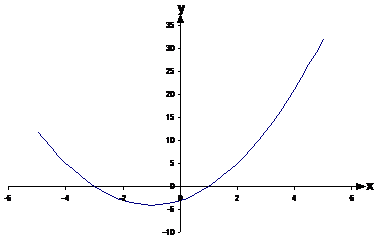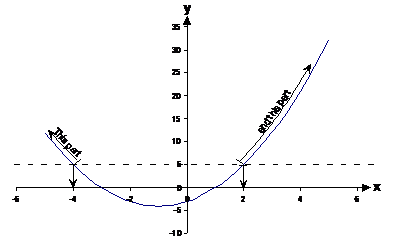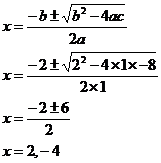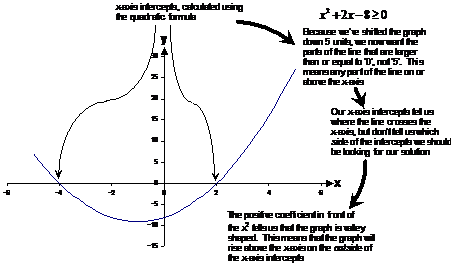Parabolic inequations and finite differences
A normal parabola should be quite familiar to everyone. For instance, check out this quadratic function and its graph:
![]()
Sponsored Links

Parabolic inequations are all about finding the values of ‘x’ (or whatever is plotted on the horizontal axis) that satisfy (make true) an inequation, like this one:
![]()
Notice how this is similar to the quadratic function we just plotted, except with a larger than or equal sign and a number on the other side of it instead of a ‘y’.
What we’re looking for is parts of the graph which are larger than or equal to ‘5’, in the ‘y’ direction:

There are two sections of the graph that are larger than or equal to 5 in the y direction – the part for x values smaller than or equal to ‘–4’, and the part for x values larger than or equal to ‘2’. In mathematical set notation our answer would be:
![]()
Remember the ‘U’ symbol is the union symbol – in this situation it means the solution is, “all the x values smaller than or equal to –4 and all the x values larger than or equal to 2.”
Solving it analytically
You can also solve it by manipulating the inequation. If we moved the entire line 5 downwards, then the x-axis intercepts would be the points at which our solutions started. This is the same thing as taking 5 away from both sides of the inequation:
![]()
Now we’ve got a new inequation we’re trying to
solve, with ‘0’ on one side. If we solve the equivalent equation, we
can work out the points at which ![]() equals 0:
equals 0:
For ![]() :
:

So our graph would cross through the x-axis at ‘2’
and ‘–4’. Now because the ‘a’ coefficient is positive (+1), this means the
graph is a valley-like graph, with a minimum. This minimum has to be located
somewhere between ![]() and
and ![]() . This means as we travel outwards
from this minimum through ‘–4’ and ‘2’ on the x-axis, our line is going to go
from below the x-axis to above the x-axis. We’re looking for values
larger than or equal to ‘0’, so this means we want the values from
. This means as we travel outwards
from this minimum through ‘–4’ and ‘2’ on the x-axis, our line is going to go
from below the x-axis to above the x-axis. We’re looking for values
larger than or equal to ‘0’, so this means we want the values from ![]() outwards in the
negative direction, and from
outwards in the
negative direction, and from ![]() outwards in the positive
direction. So in other words, we get our previous answer again:
outwards in the positive
direction. So in other words, we get our previous answer again:
![]()
This graph summarises what we have done:

So the general analytical solution is to:
· Modify the inequation so that there is a ‘0’ on one side, by adding or subtracting an amount
· Solve for the x-axis intercepts of this new inequation, treating it as if it was an equation.
· Look at the coefficient in front of the squared term. If it’s positive, the graph is a valley type graph. This means that the line goes positive as you move outwards through the x-axis intercepts. If the coefficient is negative, the graph is a hill type graph. This means the line goes positive as you move inwards through the x-axis intercepts.
·
Work out where your solution is based on the last step and
whether you’ve got ![]() symbols, or
symbols, or ![]() symbols.
symbols.
The last step might require some explaining. Say I
have an inequation like ![]() . The coefficient in front of my
. The coefficient in front of my ![]() term is
negative. Where do I look for my solutions once I’ve found my x-axis
intercepts?
term is
negative. Where do I look for my solutions once I’ve found my x-axis
intercepts?
Well, the negative coefficient means it’s a hill type graph. This means that as I move outwards through my x-axis intercepts the line will be going negative. I’m interested in the parts of the graph that are smaller than 0, or negative, so that’s where I search for my solution – outwards in the positive and negative directions of my two x-axis intercepts. Also, because it’s just a ‘smaller than’, not ‘smaller than or equal to’ symbol, my answer’s going to be something like this:
![]()
Note the larger than symbols (not larger than or equal to).
Handy Hint #1 - Watch the sign, and there may not be a solution
Make sure you take note of whether it’s just a larger than / smaller than symbol, or a larger than / smaller than or equal to symbol.
Some questions won’t have a solution.
For instance, there is no solution to ![]() , because if you plot the graph of
, because if you plot the graph of ![]() , the line never
ever gets as small as –100 in the y direction.
, the line never
ever gets as small as –100 in the y direction.

